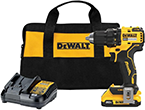Door latches are an often overlooked part of the door. In fact, about the only time that these particular parts of the door are really noticed is when something goes wrong with them. If you find your door latch is having problems, or you simply want to replace it, follow these instructions. Repairing a door latch isn't a very difficult job, and is something that every home owner can accomplish in just a few minutes of effort.
Materials Needed:
- Drill
- Complete bit set
- Long screws (or nails)
- Hammer
- Work gloves
- Utility knife
- Wood putty
- Pliers
Procedures:
- Locate the problem. One of the major issues with repairing a door latch is to actually locate the problem that you are facing. Often the problem can be due to slight molding or hinge problems rather than the with the actual latch. Inspect the door, the door latch, the hinges, the molding, and anything else that is associated with the opening and closing of the door to ensure that you have located the problem or problems.
- Move molding if necessary. If the problem is with the molding you may need to move things around a bit. For example, if the molding is loose you may will need to gently move it back into the proper place and then use either a nail or screw to help hold it in place. Another option to hold it in place is to use some wood glue, though that is a bit messy and frustrating to use. In the event that the molding is a little too large for the space it is in, use a utility knife to carefully trim it back to the proper size. It may be necessary to completely remove the molding, and replace it with some new molding that will fit properly, though that is a rather extreme case. In such situations make sure that you fill up any previous holes in the door or wall with wood putty.
- Tighten things down. It is entirely possible that your door latch itself has come loose, and or needs to be replaced. In these situations it is best to try and tighten everything down. One of the simpler methods to do this is use a slightly longer screw and drive it into the preexisting holes in the door. However, in the event that that does not work, simply remove the door latch, fill in the holes with some wood putty or filler, and then allow it to dry. Once the filler or putty has dried, go ahead and sand everything down so that it is nice and smooth. Using your drill, and the appropriate screwdriver bit, and drive your screws into the proper location. For all intents and purposes this is like reattaching your door latch to the door for the first time.
- Don't forget the hinges. Another common cause for door latch problems is if the door hinges aren't properly aligned or have become loose over time. In such situations you will want to use the same methods listed above to help tighten them down as well. In the even that you have to remove the hinges, go ahead and remove both hinges so that there isn't any excessive amount of pressure or weight placed on the remaining hinges and screws.
Now that you have finished repairing your door latch, there are only a couple of things that you still need to do. The first is to clean up after yourself. Put all your tools away, and dispose of any garbage or debris properly so that you don't leave a mess that someone can step on and potentially get hurt. The final task that you have before you is to keep an eye on your repair work and maintain it throughout the future. It is all too easy for repair work to need additional care over time, so stay on top of it and don't let it become too much of a problem if you can avoid it.
Author Bio
Lee Wyatt
Contributor of numerous Tips.Net articles, Lee Wyatt is quickly becoming a regular "Jack of all trades." He is currently an independent contractor specializing in writing and editing. Contact him today for all of your writing and editing needs! Click here to contact. Learn more about Lee...
Painting Your Gutters
Painting your gutters is a task that can do much more than improve the looks of your home. When done properly, they can ...
Discover More
Sliced Cucumber
Whether on a salad, sandwich, or as a simple tasty treat, sliced cucumber is always a favorite. Unfortunately, even ...
Discover More
Hard Boil an Egg
It may sound easy to do, but surprisingly hard boiling an egg is actually a fairly tricky thing to do. For some reason it ...
Discover More
More Home Improvement Tips
Tightening a Door Hinge
Chances are that if you walked through your home right now, you could find at least one door that has a loose door hinge. ...
Discover More
Installing a Hinged Patio Door
Patio doors are a great way to bring the great outdoors inside your home, and one of the most popular choices are hinged ...
Discover More
Installing a Deadbolt in an Aluminum Door
Of all the possible ways to make your home a little safer, one of those most commonly used options is a deadbolt. ...
Discover More

Comments